
Jan 14, 2021 | Courage, Creativity, Intention, Leadership, Transition & Change, Truth
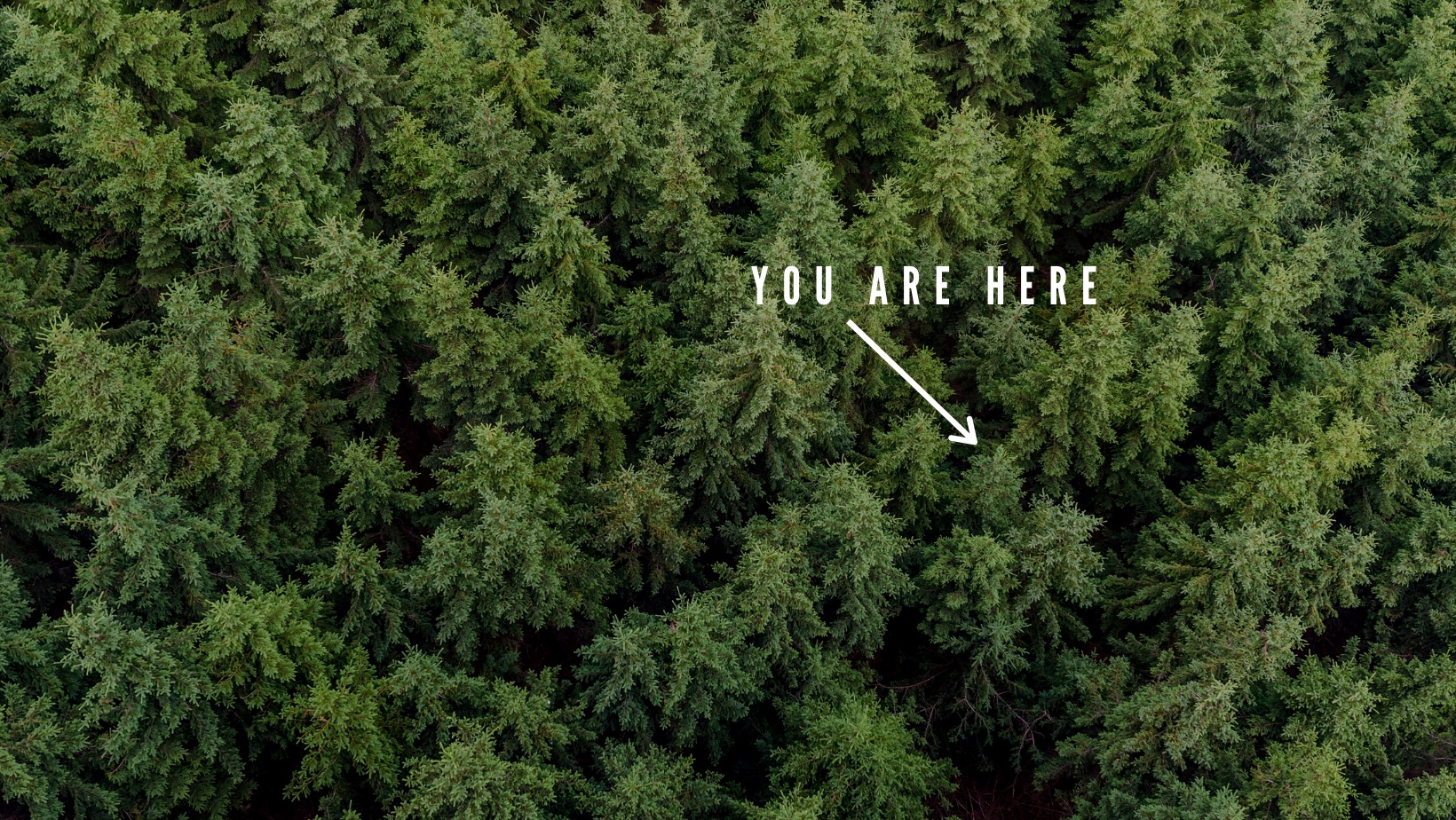 We’ve been waiting. Waiting for 2020 to end and 2021 to finally arrive. But the turn of the calendar didn’t solve our problems – in fact, not much feels different at all. If anything, it feels like a continued or even an increased sense of unknown, uncertainty, and chaos.
We’ve been waiting. Waiting for 2020 to end and 2021 to finally arrive. But the turn of the calendar didn’t solve our problems – in fact, not much feels different at all. If anything, it feels like a continued or even an increased sense of unknown, uncertainty, and chaos.
Since March 2020, I’ve often felt like I’m in the middle of a dense forest with no obvious way out. My “way” has become one of putting one foot in front of the other, literally taking the next step, and then the next. Most days, this helps me feel like I’m making progress, albeit slow.
My consulting and executive coaching work focuses on helping leaders and their organizations navigate change and transition. These days, I lean on my own practices…a lot. One of my favorite sources is the work of William Bridges and the Bridges Transition Model. In his book, “Managing Transitions,” he presents the stages of transition: Letting Go, the Neutral Zone, and the New Beginning. Let’s take a look at the Neutral Zone he describes.
The Neutral Zone
“It’s a time when all the old clarities break down and everything is in flux. Things are up in the air. Nothing is a given anymore, and anything could happen. No one knows the answers: one person says one thing and someone else says something completely different.”
Sound familiar?
This Neutral Zone is a huge chasm of discomfort between an ending and a new beginning. We’re waiting – for a new president to take office, for spring to come, for a vaccine to be widely available, to return to school and work, to hug our friends and family, and to travel. Waiting, waiting, waiting. Telling yourself it’ll be worth the wait, but also feeling exhausted, isolated, and worried because time can feel like a finite resource.
Bridges continues, “One of the most difficult aspects of the Neutral Zone is that most people don’t understand it. They expect to be able to move straight from the old to the new. But this isn’t a trip from one side of the street to the other. It’s a journey from one identity to another, and that kind of journey takes some time. The attitudes, outlook, values, self-images, and ways of thinking that were functional in the past have to ‘die’ before people can be ready for life in the present.”
So, what do we do in this neutral zone? What do we do while we wait? How are you in this zone? Probably like you, one day I’m up, the next I’m down. Some days I’m optimistic, others, I can’t find that optimism no matter what I do or how hard I try.
But hang on…there’s hope!
As we’ve sustained in this abyss now for nearly 12 months, I’m learning to be with it and also recognize it for its gifts and opportunity. Somehow, it helps to know we’re all in it together…it literally feels like there’s not one person on the planet with a “ticket” to escape this time of pandemic, social and racial injustice and unrest, and political turmoil. We’re faced with doing our work and living our life the best we can. What feels most right to me is openness, kindness, compassion, flexibility.
“This is not the wasted time of meaningless waiting and confusion that it sometimes seems to be,” offers Bridges. “It’s a time when reorientation and redefinition must take place, and people need to understand that.”
Yes, it’s a time of anxiety and even chaos, but also it is a time when we’re more open to new ideas and opportunity. I remind myself daily that there’s power in this place. For me:
- Priorities have become clearer, and I realize what’s most important in my life.
- I can do with less. A lot less, in fact: money, material things, activities, work hustle…all the busyness
- Losing what “was” is teaching me to exercise my creativity and look for new opportunities to cultivate and apply myself – my interests, skills, talent, and experience. Coupling this with new insight around my priorities is giving way to a new and more aligned path.
- I’m reminded to celebrate the highs and the wins, even the smallest wins (especially those!)
- I look for the lessons in the lows and greatest challenges.
- I realize that my happiness and power come from within. I’m developing my spirituality practice to help me tap into that.
Since March, I’ve discovered that not only does my old way not work now, but I no longer even wish for that way. There are many things I quite like about this middle place and how the present is informing what I’m building. I’m learning to trust myself and my intuition and inner voice much more every day.
How are you finding ways to maximize and leverage your neutral zone?
 Hi, I’m Jeanie Duncan. I work with individuals and organizations as a transformation partner to help them unlock their Truth, discover authentic value, and create meaningful impact in the world. I believe when we are truly aligned with our purpose, we can live and perform at our highest potential. With over 25 years of experience as an executive, CEO, consultant, coach, and writer, I offer strategic, knowledgeable, and experienced guidance for those who are ready to take the courageous leap toward true transformation.
Hi, I’m Jeanie Duncan. I work with individuals and organizations as a transformation partner to help them unlock their Truth, discover authentic value, and create meaningful impact in the world. I believe when we are truly aligned with our purpose, we can live and perform at our highest potential. With over 25 years of experience as an executive, CEO, consultant, coach, and writer, I offer strategic, knowledgeable, and experienced guidance for those who are ready to take the courageous leap toward true transformation.

Jan 5, 2021 | Action, Focus, Intention, Strategy
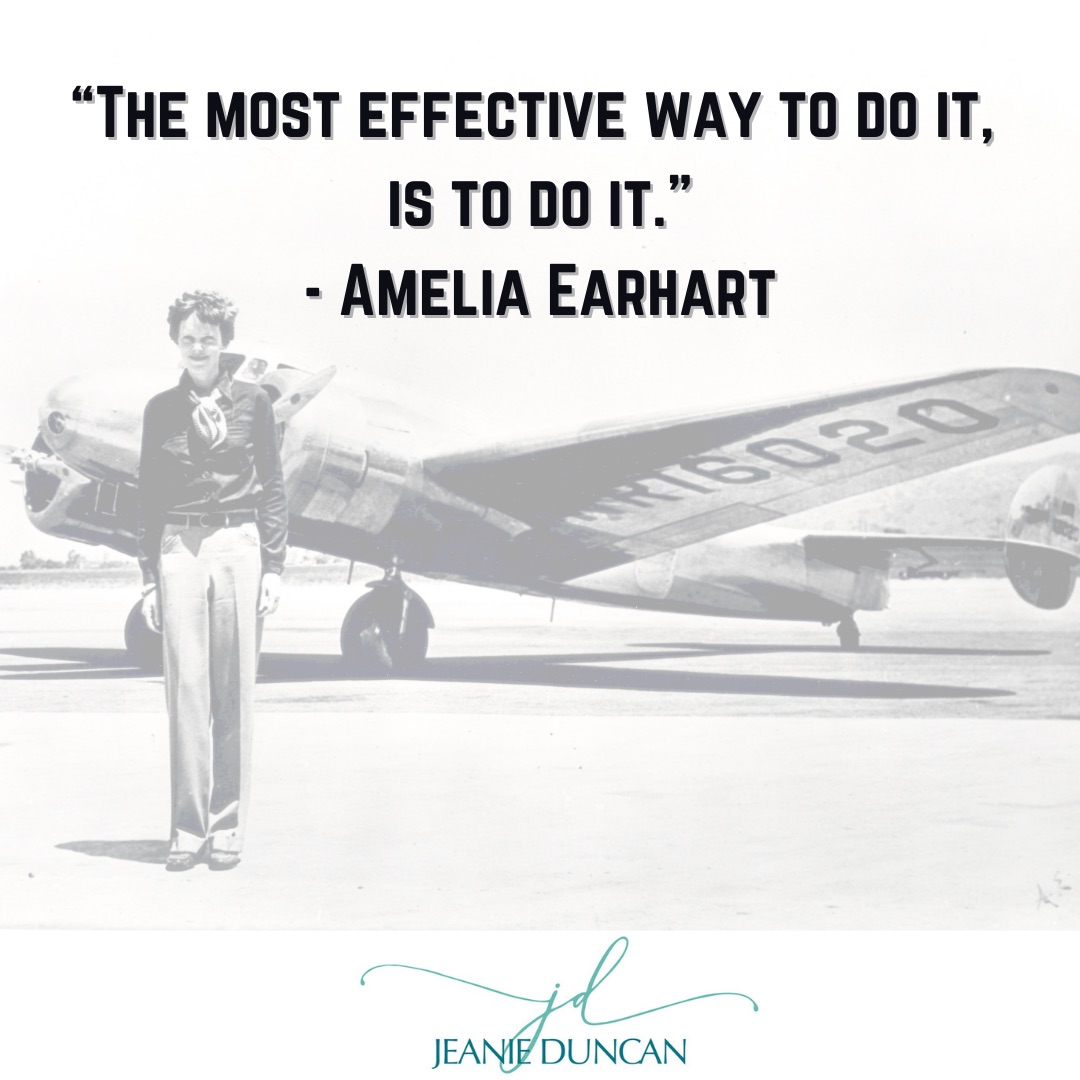
For my 2021 intention setting, I’ve picked this Amelia Earhart quote and two words as my guideposts: Immerse + Commit.
I love variety – a lot of things, options, choices. If I were to describe my life as a buffet line, when I reach the end, my plate would be piled high and about to break under the mountain of food – everything looked so good, so I took just a little bit…and then the little became a LOT.
This lived experience can have me setting too many goals, taking on too many clients and projects, and casting a net too wide because it all looks so delicious!
My “way,” while exciting and filled with variety, often keeps me from having the rich depth of experience I want to have. It also prevents me from truly committing to something and finishing or mastering it, because of the sheer heap of assortment.
So, for 2021 I’m immersing in and committing to a small “salad plate” of:
- Writing
- Coaching
- Work in equity, inclusion and diversity
- My overall health and wellness
And my shero, Amelia, with her “the most effective way to do it, is to do it” will guide me through!
2021 Planning Guide
Here are a few prompts that support my clients with intention and priority setting. I hope you find them helpful to do your own 2021 reflection.
- Identify up to 3 items that you want as your MAIN areas of focus for the year. For each area, provide a simple heading (written in first person) that states what you want to have achieved by December 31. Underneath each, note one or more measurable outcomes you will see/experience as a result.
- For these areas of focus, what do you anticipate that might hold you back or get in your way? Listing these can help you be prepared for potential barriers and to prevent them before they arise.
- What theme (or themes) encapsulates the above areas of focus?
- Of the theme(s) you’ve listed, what word or two best captures the essence?
- Identify a quote that can serve as a “headline” or “billboard” for you, related to your key words. (Searching quotes based on your key words or themes is helpful.)
It’s a good idea to post your results to this “worksheet’ in a place where you’ll see it every day. I have mine on my office wall and placed as a “bookmark” in my daily writing journal. Cheers!
 Hi, I’m Jeanie Duncan. I work with individuals and organizations as a transformation partner to help them unlock their Truth, discover authentic value, and create meaningful impact in the world. I believe when we are truly aligned with our purpose, we can live and perform at our highest potential. With over 25 years of experience as an executive, CEO, consultant, coach, and writer, I offer strategic, knowledgeable, and experienced guidance for those who are ready to take the courageous leap toward true transformation.
Hi, I’m Jeanie Duncan. I work with individuals and organizations as a transformation partner to help them unlock their Truth, discover authentic value, and create meaningful impact in the world. I believe when we are truly aligned with our purpose, we can live and perform at our highest potential. With over 25 years of experience as an executive, CEO, consultant, coach, and writer, I offer strategic, knowledgeable, and experienced guidance for those who are ready to take the courageous leap toward true transformation.

Nov 17, 2020 | Creativity, Focus, Intention
 A few weeks ago, I began the practice of “morning pages” again, and I feel the shifting of my internal tectonic plates.
A few weeks ago, I began the practice of “morning pages” again, and I feel the shifting of my internal tectonic plates.
For those unfamiliar with morning pages, the tool comes from Julia Cameron in her book, The Artist’s Way, where she guides readers on a path to freeing their internal creative self, and introduces this pivotal daily morning writing ritual.
The idea is that you awake and, first thing as you rise, free write for about 30 minutes, emptying yourself of thoughts, ideas, wonderings, and such. Keep the pen moving for 2–3 pages’ worth and whatever comes, comes. The purpose isn’t to produce anything spectacular, although sometimes you might! Simply write.
For the last ten years, I’ve been on again, off again with this practice. Every time I start back, I wonder why I ever stop. For in these pages over time, I’ve scoped out a yearlong sabbatical, launched a business, and discovered and claimed my identity as a gay woman. Shifting plates…
I think of morning pages as a writing meditation of sorts – I watch my thoughts and feelings flow from my pen onto paper as I release about events, experiences, and dreams, and with them, anger, fear, love, joy, loss, excitement. I let go, I imagine, I question, I leap. I’m safe here – free to be whoever I am in this space and be with whatever emerges.
A practice so simple, yet I feel its quake. This time, it’s revealing my inner creative, me claiming who I am as a writer. A professional writer. Not an amateur, or hobbyist, and my craft isn’t play or my sidekick – although the roar of resistance sometimes tries to convince me otherwise.
This time around while reading The Artist’s Way, a particular passage really stood out to me – the one where Cameron describes the shadow artist…
“Artists themselves, but ignorant of their true identity, shadow artists are to be found shadowing declared artists. They often choose shadow careers – those close to the desired art, even parallel to it, but not the art itself.”
“Artists love other artists. Shadow artists often gravitate to their rightful tribe but cannot yet claim their birthright. They want to write. They want to paint. They want to act, make music, dance…but they are afraid to take themselves seriously.”
“In order to move from the realm of shadows into the light of creativity, shadow artists must learn to take themselves seriously.”
I thought, “Could this be me?”
As I process coming out of this creative closet, it feels like the fruition of a decades-long crescendo.
- As a child, I grew up with arts and creativity. My older sister, Melinda, and I took piano lessons and played our entire childhood. I performed flute in the school band, sang in my church choir and school chorus, wrote for my school yearbook and newspaper, and took up photography as a hobby when I got a camera for high school graduation.
- In college, I studied journalism and wrote and photographed for university publications. And although I didn’t plan it, my early work out of college took me down a professional path of nonprofit arts administration – my first job with a private music academy, and a dozen years later I became CEO of an urban arts council…truly my dream job.
- When I left that post, I took a sabbatical for a few months to gain clarity on what would come next in my career. How did I spend the time? I painted for the first time in my life, I learned Spanish with my son, I took up guitar lessons again, and I started a blog as a new writing challenge – all arts-related pursuits. I’d spent so many years helping arts organizations and artists build capacity and develop resources, that I was drawn to finally explore my own creativity again. The space and playground of the sabbatical inspired me to start my own business focused on my passion of helping people and organizations transform.
- So attracted to artists I am, that I fell in love with one, and in October this year, I married Lyn Koonce – a professional contemporary folk musician. Music fills our home, and I have a front row seat to her amazing work and recent new album launch.
As I reflect back on this trajectory through my recent morning pages, I can see how central art and creative expression have been to who I am and who I’m becoming.
If indeed I have been the shadow artist Cameron describes, I feel myself emerging from that and claiming my artist self. I’m a bit in awe of the revelations that come from this practice. Plates shifting…
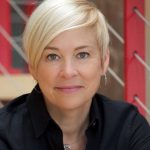 Hi, I’m Jeanie Duncan. I work with individuals and organizations as a transformation partner to help them unlock their Truth, discover authentic value, and create meaningful impact in the world. I believe when we are truly aligned with our purpose, we can live and perform at our highest potential. With over 25 years of experience as an executive, CEO, consultant, coach, and writer, I offer strategic, knowledgeable, and experienced guidance for those who are ready to take the courageous leap toward true transformation.
Hi, I’m Jeanie Duncan. I work with individuals and organizations as a transformation partner to help them unlock their Truth, discover authentic value, and create meaningful impact in the world. I believe when we are truly aligned with our purpose, we can live and perform at our highest potential. With over 25 years of experience as an executive, CEO, consultant, coach, and writer, I offer strategic, knowledgeable, and experienced guidance for those who are ready to take the courageous leap toward true transformation.
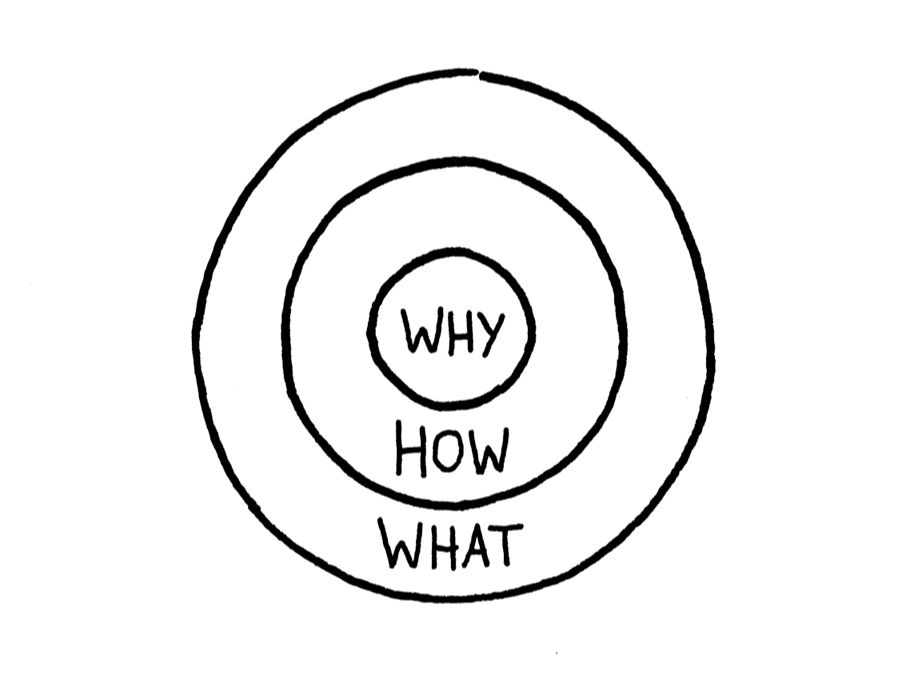
Feb 10, 2015 | Leadership
I recently completed some forecasting and goal setting for my business. As I went through this process, I pulled from several resources that inspire and motivate me, a favorite of which is Simon Sinek’s “Start With WHY.” He expresses his message through what he calls The Golden Circle:

His premise is that you must begin with your WHY, and from there figure out your HOW and WHAT. When Sinek studied successful leaders, he found a common denominator – they inspire through a clearly and passionately articulated WHY. They hold their WHY front and center – like a North Star – to guide their WHAT and HOW. Everything emerges from the core WHY, or belief. HOWs are the actions they take to realize that belief. And WHATs are the results of those actions.
I’ve known about Sinek’s philosophy for a while, but I find even greater meaning in it now – not only for my own personal and business reflection, but also for my clients.
According to this line of thought, most every person and organization knows WHAT they do. That’s usually pretty clear. Some know HOW they do it. But very few know WHY they do WHAT they do. Or at least they don’t stop to think about it or articulate it frequently and consistently.
By WHY, Sinek doesn’t mean ‘to earn revenue,’ but rather, he’s referring to your purpose, your cause, your belief. Sinek asks, “WHAT makes you get out of bed in the morning? WHY do you care? And WHY should others care?” Think of it as communicating from the inside out.
Think for a moment – We busily go about our day-to-day. We take on roles, assignments, projects, and business…and before long we’ve amassed this huge volume of ‘stuff’ without pausing to think about WHY we’re doing it. Even if we know our WHY, we can fail to consciously use it as our lens or filter for making decisions.
As I went through my own reflection, I see room for getting clearer with my own “WHY” and doing a better job of sharing my story.
A theme for me over my life is that I’m a self-starter and risk taker. I grew up in an entrepreneurial family with my parents owning two businesses. My siblings and I were involved in those businesses where there was no task too great or small; we all pitched in to get it done. And if we didn’t know how to do it, we figured it out. Failures were acknowledged as just one step closer to succeeding.
When I finished college, my first jobs were new positions where I was responsible for creating the role. Later on, I set my vision and sites for what I wanted and set out to achieve it, including starting my own business. Through it all, I didn’t have all the information, the guidelines were ambiguous, and I needed to perform and produce results fast. I quite like this messiness – stepping into the unknown, bringing order to chaos, and charting a course where there isn’t one.
This pattern and energy shapes my WHY – To help people know WHAT they want, find their courage, step forward, and take risks. This is the path to which my life and my work is devoted.
Sinek offers, “People don’t buy WHAT you do. They buy WHY you do it. People don’t buy WHAT you sell. They buy WHAT you believe. And people follow you not because they have to, not because they are paid to, but because they want to.”
This concept comes alive every day in business:
- Strategy Development: For an organization to develop its goals, strategies, and tactics, it must first be crystal clear on its WHY, often presented most succinct in a well-crafted vision and mission. As Sinek offers, “It’s not just WHAT or HOW you do things that matters; what matters more is that your WHAT and HOW is consistent with your WHY.” With a WHY clearly stated in an organization, anyone within the organization can make a decision as clearly and as accurately as the top leader.
- Sustainability Planning: The products and services offered by many organizations are broad and complex. It’s important to critically and regularly examine these lines of business and ask, “WHY do we do this,” looking at both mission impact and financial return to gauge long-term sustainability. Yet, we can get so caught up in the day-to-day, that our WHAT mutates into a complex web without a clear connection to vision and mission, and with limited (or lost) return on investment.
- Succession Planning and Leadership Transitions: Sinek concludes that top executives are successful in great part because they inspire and embody what they believe. When the person who personifies the WHY departs without clearly articulating WHY the company was founded in the first place, they leave no clear cause for their successor to lead. “Successful succession is more than selecting someone with an appropriate skill set – it’s about finding someone who is in lockstep with the original cause around which the business was founded. Great 2nd and 3rd CEOs don’t take the helm to implement their own vision of the future; they pick up the original banner and lead the company into the next generation.”
I encourage you to get to your WHY. It yields greater confidence than ‘I think it’s right.’ It’s more scalable than ‘I feel it’s right.’ When you know your WHY, the highest level of assurance you can offer is, ‘I know it’s right.’
_______
Sinek, S. (2009). Start with why: how great leaders inspire everyone to take action. New York: Penguin Group.
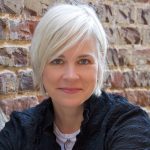 About Jeanie Duncan: Jeanie is President of Raven Consulting Group, a business she founded that focuses on organizational change and leadership development in the nonprofit sector. She is a senior consultant for Raffa, a national firm working with nonprofit clients to lead efforts in sustainability and succession planning, executive transition and search. Additionally, Jeanie serves as adjunct faculty for the Center for Creative Leadership, a top-ranked, global provider of executive leadership education.
About Jeanie Duncan: Jeanie is President of Raven Consulting Group, a business she founded that focuses on organizational change and leadership development in the nonprofit sector. She is a senior consultant for Raffa, a national firm working with nonprofit clients to lead efforts in sustainability and succession planning, executive transition and search. Additionally, Jeanie serves as adjunct faculty for the Center for Creative Leadership, a top-ranked, global provider of executive leadership education.

Dec 22, 2014 | Intention

January lures me to a place of reflection of the prior year and intention and goal setting for the year ahead. It’s my way of honoring life events, learning from what I’ve experienced, and dreaming of what I most want.
Over time, I’ve developed a some tools that serve me well in this process. Here are a few favorites that I hope you will find of value.
- Take a blank sheet of paper and draw a vertical line down the middle of the page. On the left side at the top, write “Freedom From” (What do I want to STOP doing?). On the right side, write “Freedom Toward” (What do I want to be or START doing?). Then down the far left column, write these words: Career, Family & Friends, Significant other / Romance, Fun & Recreation, Health, Money, Personal Growth, and Physical Environment. Complete each column in terms of ‘freedom from’ and ‘freedom toward’. This exercise will help you create alignment in the direction toward what matters most.
- Another exercise I find valuable is completing Stephen Covey’s Time Management Matrix, which I have sample-populated below from a business perspective. I like to do this including both work and family elements, sometimes in two different grids. I don’t know about you, but much of my day quickly can be filled with the 3rd quadrant – the seemingly urgent, but less important things. At the end of those days, it’s hard to note anything meaningful that I’ve accomplished. Ideally, I use this tool not only at the beginning of a new year, but also at the beginning of each month and week to keep me focused on what matters most.

- Journaling can be another effective outlet to reflect and draw out thoughts about the past year and help focus and imagine the 12 months ahead. Consider the writing prompts below as you complete this exercise.
Reflecting on the prior year:
- What am I celebrating?
- What were the most significant events of the year past?
- What’s going well? …not so well?
- How am I leveraging my strengths?
- What did I learn? (skills, knowledge, insights, etc.)
- What would I have done differently?
- What did I complete or release? What still feels incomplete to me?
- How am I different this year than last?
- For what am I particularly grateful?
Imagining the year ahead:
- What intentions do I have for the coming year?
- What is the commitment I want to make for: my work, my family, my self?
- How do I want to approach things differently?
- How do I want to spend my time?
- What would I do if I knew I couldn’t fail?
- How and with whom do I most want to spend my time?
- How will I honor my core values?
- Imagine that it is 6 months from now, and I’ve acted on my intentions or met my goals. What is like? How does it feel? What resources and support surround me?
A final critical piece to goal setting is to enroll an accountability partner. As you refine your intentions and goals for the year, ask a friend or colleague to help support you and hold you accountable. Set a schedule where s/he will followup and ask you about your progress. They can serve as an important ally in helping you move past barriers as well as celebrate your progress (big and small). Choose someone who will challenge and stretch you and call you out when you’re playing small!
Best wishes to you in this experience and bringing forth your best self in the year ahead!
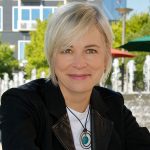 About Jeanie Duncan: Jeanie is President of Raven Consulting Group, a business she founded that focuses on organizational change and leadership development in the nonprofit sector. She is a senior consultant for Raffa, a national firm working with nonprofit clients to lead efforts in sustainability and succession planning, executive transition and search. Additionally, Jeanie serves as adjunct faculty for the Center for Creative Leadership, a top-ranked, global provider of executive leadership education.
About Jeanie Duncan: Jeanie is President of Raven Consulting Group, a business she founded that focuses on organizational change and leadership development in the nonprofit sector. She is a senior consultant for Raffa, a national firm working with nonprofit clients to lead efforts in sustainability and succession planning, executive transition and search. Additionally, Jeanie serves as adjunct faculty for the Center for Creative Leadership, a top-ranked, global provider of executive leadership education.

 We’ve been waiting. Waiting for 2020 to end and 2021 to finally arrive. But the turn of the calendar didn’t solve our problems – in fact, not much feels different at all. If anything, it feels like a continued or even an increased sense of unknown, uncertainty, and chaos.
We’ve been waiting. Waiting for 2020 to end and 2021 to finally arrive. But the turn of the calendar didn’t solve our problems – in fact, not much feels different at all. If anything, it feels like a continued or even an increased sense of unknown, uncertainty, and chaos. Hi, I’m Jeanie Duncan. I work with individuals and organizations as a transformation partner to help them unlock their Truth, discover authentic value, and create meaningful impact in the world. I believe when we are truly aligned with our purpose, we can live and perform at our highest potential. With over 25 years of experience as an executive, CEO, consultant, coach, and writer, I offer strategic, knowledgeable, and experienced guidance for those who are ready to take the courageous leap toward true transformation.
Hi, I’m Jeanie Duncan. I work with individuals and organizations as a transformation partner to help them unlock their Truth, discover authentic value, and create meaningful impact in the world. I believe when we are truly aligned with our purpose, we can live and perform at our highest potential. With over 25 years of experience as an executive, CEO, consultant, coach, and writer, I offer strategic, knowledgeable, and experienced guidance for those who are ready to take the courageous leap toward true transformation. 



 A few weeks ago, I began the practice of “morning pages” again, and I feel the shifting of my internal tectonic plates.
A few weeks ago, I began the practice of “morning pages” again, and I feel the shifting of my internal tectonic plates. Hi, I’m Jeanie Duncan. I work with individuals and organizations as a transformation partner to help them unlock their Truth, discover authentic value, and create meaningful impact in the world. I believe when we are truly aligned with our purpose, we can live and perform at our highest potential. With over 25 years of experience as an executive, CEO, consultant, coach, and writer, I offer strategic, knowledgeable, and experienced guidance for those who are ready to take the courageous leap toward true transformation.
Hi, I’m Jeanie Duncan. I work with individuals and organizations as a transformation partner to help them unlock their Truth, discover authentic value, and create meaningful impact in the world. I believe when we are truly aligned with our purpose, we can live and perform at our highest potential. With over 25 years of experience as an executive, CEO, consultant, coach, and writer, I offer strategic, knowledgeable, and experienced guidance for those who are ready to take the courageous leap toward true transformation.






Recent Comments